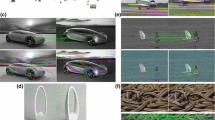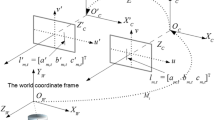Abstract
This paper describes the geometry of imaged curves in two and three views. Multi-view relationships are developed for lines, conics and non-algebraic curves. The new relationships focus on determining the plane of the curve in a projective reconstruction, and in particular using the homography induced by this plane for transfer from one image to another. It is shown that given the fundamental matrix between two views, and images of the curve in each view, then the plane of a conic may be determined up to a two fold ambiguity, but local curvature of a curve uniquely determines the plane. It is then shown that given the trifocal tensor between three views, this plane defines a homography map which may be used to transfer a conic or the curvature from two views to a third. Simple expressions are developed for the plane and homography in each case.
A set of algorithms are then described for automatically matching individual line segments and curves between images. The algorithms use both photometric information and the multiple view geometric relationships. For image pairs the homography facilitates the computation of a neighbourhood cross-correlation based matching score for putative line/curve correspondences. For image triplets cross-correlation matching scores are used in conjunction with line/curve transfer based on the trifocal geometry to disambiguate matches. Algorithms are developed for both short and wide baselines. The algorithms are robust to deficiencies in the segment extraction and partial occlusion.
Experimental results are given for image pairs and triplets, for varying motions between views, and for different scene types. The methods are applicable to line/curve matching in stereo and trinocular rigs, and as a starting point for line/curve matching through monocular image sequences.
Similar content being viewed by others
References
Ayache, N. 1990. Stereovision and Sensor Fusion. MIT Press.
Ayache, N. and Faverjon, B. 1987. Efficient registration of stereo images by matching graph descriptions of edge segments. International Journal of Computer Vision, 1(2):107–132.
Ayache, N. and Lustman, F. 1987. Fast and reliable passive stereovision using three cameras. In International Conference on Computer Vision, pp. 422–427.
Baillard, C., Schmid, C., Zisserman, A., and Fitzgibbon, A. 1999. Automatic line matching and 3D reconstruction of buildings from multiple views. In ISPRS Conference on Automatic Extraction of GIS Objects from Digital Imagery, IAPRS vol. 32, Part 3-2W5, pp. 69–80.
Beardsley, P., Torr, P., and Zisserman, A. 1996. 3D model acquisition from extended image sequences. In European Conference on Computer Vision, pp. 683–695.
Bignone, F., Henricsson, O., Fua, P., and Stricker, M. 1996. Automatic extraction of generic house roofs from high resolution aerial imagery. In European Conference on Computer Vision, pp. 85–96.
Blake, A. and Cipolla, R. 1990. Robust estimation of surface curvature from deformation of apparent contours. In European Conference on Computer Vision, pp. 465–474.
Bookstein, F.L. 1979. Fitting conic sections to scattered data. Computer Graphics and Image Processing, 9:56–71.
Brint, A.T. and Brady, M. 1989. Stereo matching of curves by least deformation. In InternationalWorkshop on Intelligent Robots and Systems, pp. 163–170.
Carlsson, S., Mohr, R., Morin, L., Rothwell, C., Van Gool L., Veillon, F., and Zisserman, A. 1996. Semi-local projective invariants for the recognition of smooth plane curves. International Journal of Computer Vision, 19(3):211–236.
Chung, R.C.K. and Nevatia, R. 1991. Use of monocular groupings and occlusion analysis in a hierarchical stereo system. In Conference on Computer Vision and Pattern Recognition, pp. 50–56.
Cipolla, R., Astrom, K., and Giblin, P. 1995. Motion from the frontier of curved surfaces. In International Conference on Computer Vision, pp. 269–275.
Cipolla, R. and Zisserman, A. 1992. Qualitative shape from deformation of image curves. International Journal of Computer Vision, 8(1):53–69.
Cross, G. and Zisserman, A. 1998. Quadric reconstruction from dualspace geometry. In International Conference on Computer Vision, pp. 25–31.
Crowley, J.L. and Stelmazyk, P. 1990. Measurement and integration of 3D structures by tracking edges lines. In European Conference on Computer Vision, pp. 269–280.
Deriche, R. and Faugeras, O. 1990. Tracking line segments. In European Conference on Computer Vision, pp. 259–267.
Faugeras, O. 1992. What can be seen in three dimensions with an uncalibrated stereo rig? In European Conference on Computer Vision, pp. 563–578.
Faugeras, O. 1993. Three-Dimensional Computer Vision– A Geometric Viewpoint. Artificial intelligence. MIT Press.
Faugeras, O. and Keriven, R. 1998. Complete dense stereovision using level set methods. In European Conference on Computer Vision, pp. 379–393.
Faugeras, O. and Papadopoulo, T. 1993. A theory of the motion fields of curves. International Journal of Computer Vision, 10(2):125–156.
Faugeras, O. and Robert, L. 1996. What can two images tell us about a third one? International Journal of Computer Vision, 18(1):5–19.
Gdalyahu, Y. and Weinshall, D. 1999. Flexible syntactic matching of curves and its application to automatic hierarchical classification of silhouettes. IEEE Transactions on Pattern Analysis and Machine Intelligence, 21(12):1312–1328.
Gros, P. 1995. Matching and clustering: Two steps towards object modelling in computer vision. International Journal of Robotics Research, 14(6):633–642.
Gruen, A.W. 1985. Adaptative least squares correlation: A powerful image matching technique. S. Afr. Journal of Photogrammetry, Remote Sensing and Cartography, 14(3):175–187.
Hartley, R.I. 1995. A linear method for reconstruction from lines and points. In International Conference on Computer Vision, pp. 882–887.
Hartley, R.I. 1997. Lines and points in three views and the trifocal tensor. International Journal of Computer Vision, 22(2):125–140.
Hartley, R.I., Gupta, R., and Chang, T. 1992. Stereo from uncalibrated cameras. In Conference on Computer Vision and Pattern Recognition, pp. 761–764.
Hartley, R.I. and Zisserman, A. 2000. Multiple View Geometry in Computer Vision. Cambridge University Press.
Havaldar, P. and Medioni, G. 1995. Segmented shape descriptions from 3-view stereo. In International Conference on Computer Vision, pp. 102–108.
Horaud, R. and Skordas, T. 1989. Stereo correspondence through feature grouping and maximal cliques. IEEE Transactions on Pattern Analysis and Machine Intelligence, 11(11):1168–1180.
Huttenlocher, D.P., Klanderman, G.A., and Rucklidge, W.J. 1993. Comparing images using the Hausdorff distance. IEEE Transactions on Pattern Analysis and Machine Intelligence, 15(9):850–863.
Kahl, F. and Heyden, A. 1998. Using conic correspondences in two images to estimate the epipolar geometry. In International Conference on Computer Vision, pp. 761–766.
Laurent, P.J. 1987. Courbes ouvertes ou fermées par B-splines régularis ées. Technical Report RR 652, IMAG, Grenoble, France.
Luong, Q.T. and Viéeville, T 1996. Canonical representations for the geometries of multiple projective views. Computer Vision and Image Understanding, 64(2):193–229.
Ma, S. 1993. Conics-based stereo, motion estimation, and pose determination. International Journal of Computer Vision, 10(1):7–25.
Maybank, S.J. and Faugeras, O. 1992. A theory of self calibration of a moving camera. International Journal of Computer Vision, 8(2):123–151.
Medioni, G. and Nevatia, R. 1985. Segment-based stereo matching. Computer Vision, Graphics and Image Processing, 31:2–18.
Nayar, S.K. and Bolle, R.M. 1996. Reflectance based object recognition. International Journal of Computer Vision, 17(3):219–240.
Pollard, S.B., Pridmore, T.P., Porrill, J., Mayhew, J.E.W., and Frisby, J.P. 1989. Geometrical modeling from multiple stereo views. International Journal of Robotics Research, 8(4):132–138.
Pollard, S.B., Mayhew, J.E.W., and Frisby, J.P. 1985. PMF: A stereo correspondence algorithm using a disparity gradient constraint. Perception, 14:449–470.
Porrill, J. and Pollard, S.B. 1991. Curve matching and stereo calibration. Image and Vision Computing, 9(1):45–50.
Pritchett, P. and Zisserman, A. 1998. Wide baseline stereo matching. In International Conference on Computer Vision, pp. 754–760.
Quan, L. 1996. Conic reconstruction and correspondence from two views. IEEE Transactions on Pattern Analysis and Machine Intelligence, 18(2):151–160.
Remagnino, P., Brand, P., and Mohr, R. 1994. Correlation techniques in adaptative template matching with uncalibrated cameras. In Vision Geometry III, SPIE's international symposium on photonic sensors & control for commercial applications, vol. 2356, pp. 252–253.
Robert, L. and Faugeras, O. 1991. Curve-based stereo: Figural continuity and curvature. In Conference on Computer Vision and Pattern Recognition, pp. 57–62.
Rothwell, C., Mundy, J.L., and Hoffman, B. 1996. Representing objects using topology. In Object Representation in Computer Vision II, LNCS 1144, pp. 79–108. Springer-Verlag.
Rothwell, C., Zisserman, A., Forsyth, D., and Mundy, J. 1992. Fast recognition using algebraic invariants. In Geometric Invariance in Computer Vision, MIT Press, pp. 398–407.
Rothwell, C.A. 1993. Recognition using Projective Invariance. Ph.D. Thesis, Department of Engineering Science, University of Oxford.
Safaee-Rad, R., Tchoukanov, I., Benhabib, B., and Smit, K.C. 1992. 3D pose estimation from a quadratic curved feature in two perspective views. In International Confernce on Pattern Recognition, pp. 341–344.
Schmid, C. and Zisserman, A. 1997. Automatic line matching across views. In Conference on Computer Vision and Pattern Recognition, pp. 666–671.
Schmid, C. and Zisserman, A. 1998. The geometry and matching of curves in multiple views. In European Conference on Computer Vision, vol. I, pp. 394–409.
Semple, J. and Kneebone, G. 1979. Algebraic Projective Geometry. Oxford University Press.
Shashua, A. 1994. Trilinearity in visual recognition by alignment. In European Conference on Computer Vision, pp. 479–484.
Spetsakis, M.E. and Aloimonos, J. 1990. Structure from motion using line correspondences. International Journal of Computer Vision, 4(3):171–183.
Torr, P.H.S. and Murray, D.W. 1997. The development and comparison of robust methods for estimating the fundamental matrix. International Journal of Computer Vision, 24(3):271–300.
Torr, P.H.S. and Zisserman, A. 1997. Robust parameterization and computation of the trifocal tensor. Image and Vision Computing, 15:591–605.
Triggs, B. 1997. Auto calibration and the absolute quadric. In Conference on Computer Vision and Pattern Recognition, pp. 609–614.
Vaillant, R. 1990. Using occluding contours for 3D object modeling. In European Conference on Computer Vision, pp. 454–464.
Van Gool, L., Brill, M., Barrett, E., Moons, T., and Pauwels, E. 1992. Semi-differential invariants for nonplanar curves. In Geometric Invariance in Computer Vision, MIT Press, pp. 293–309.
Van Gool, L., Moons, L.T., Pauwels, E. and Oosterlinck, A. 1992. Semi-differential invariants. In Geometric Invariance in Computer Vision, MIT Press, pp. 157–192.
Venkateswar, V. and Chellappa, R. 1995. Hierarchical stereo and motion correspondence using feature groupings. International Journal of Computer Vision, 15(3):245–269.
Zhang, Y. and Gerbrands, J.J. 1995. Method for matching general stereo planar curves. Image and Vision Computing, 13(8):645–655.
Zhang, Z. 1994. Token tracking in a cluttered scene. Image and Vision Computing, 12(2):110–120.
Zhang, Z., Deriche, R., Faugeras, O., and Luong, Q.T. 1995. Arobust technique for matching two uncalibrated images through the recovery of the unknown epipolar geometry. Artificial Intelligence, 78:87–119.
Zisserman, A. and Maybank, S. 1994. A case against epipolar geometry. In Applications of Invariance in Computer Vision LNCS 825, Springer-Verlag, pp. 69–88.
Author information
Authors and Affiliations
Rights and permissions
About this article
Cite this article
Schmid, C., Zisserman, A. The Geometry and Matching of Lines and Curves Over Multiple Views. International Journal of Computer Vision 40, 199–233 (2000). https://doi.org/10.1023/A:1008135310502
Issue Date:
DOI: https://doi.org/10.1023/A:1008135310502




